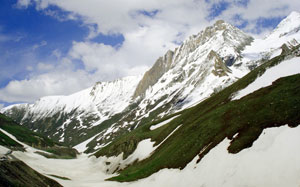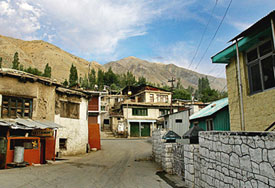|
|
|
Travel from Srinagar to Leh by Road |
|
|
|
Travelling into Ladakh by
road is exciting and of adventures nature. It takes two days
from Srinagar to Leh (434 km) with a mid way halt at Kargil,
which gives the visitor a marvelous introduction to this
spectacular destination, while easing the acclimatization
process to the high altitude low-oxygen atmosphere of Ladakh.
The road from Srinagar passes through picturesque villages on
the banks of the Sindh river. Leaving the green Sindh Valley
at Sonmarg, the first pass to be crossed is Zoji La – at a
height of 11,578 feet. Zoji-la pass in the Great Himalayan
wall is the gateway into Ladakh. On the other side of Sindh
Valley is Dras Valley which is arid. |
|
|
 |
|
Shrinagar - Leh Highway |
|
Drass is the first village
after having crossed the pass. Drass is said to be the second
coldest habitation in the world after Siberia. Local people
are of Dard origin and believed to be an Aryan people who
migrated from the Central Asian steppes. Below Tashgram starts
the granite country. Mountains rise on both sides to serrated
ridges of 17,000 to 18,0000 feet. After Drass, the valley
narrows, becoming almost a gorge. Yet even here it
occasionally allows space for small patches of terraced
cultivation, where a tiny village population feels a
precarious existence. This is indeed a mountain desert,
greened only by such scattered oases. Further the road brings
us to the little trading town of Kargil. The population is
less than 3,000 people. Kargil is situated in Suru Valley
where the Suru river flows and meets the Indus at a place
called Marul. There are a few villages in this valley at a
height of 9000 feet. That explains why it has an abundance of
fruit trees, mainly mulberry and apricot. Willows and poplars
grow along the water courses. Kargil is midway point of the
road journey to Leh. Kargil is the base to visit the
spectacular Suru and Zanskar valleys and for a variety of
adventure activities in the region. |
|
After crossing the
Suru, the road goes through a sandy plateau followed by
another narrow valley. The road also plunges into the
ridges and valley of the Zanskar range over a huge mound
of alluvium, now made fertile by a huge irrigation
scheme. You then reach Mulbekh village, around 40 km
ahead of Kargil. The famous monastery of Mulbekh is
famous for its immense figure of Maitreya (the future
Buddha). The road further climbs its adventures and
breathless |
 |
|
|
way to Namika-la pass
(12,200 feet or 3719 m) and Fotu-la pass (13,479 feet or 4094
m), giving you a real feeling, being really at the top of the
world. It sweeps past the amazing Lamayuru monastery
situated spectacularly over a mountainside down the incredible
Langroo Loops to meet the River Indus at Khalatse-a descent of
4000 feet or 1219 m in about 32 km. Lamayuru is the Ladakh’s
oldest monastery – looming like a Hollywood movie backdrop of
Shangri-La. Lamayuru is venerated. It is believed that one of
the great Tibetan teachers, Norapa, meditated here for several
years. Like all Ladakh monasteries, it is also a complex of
buildings with shrines dedicated to different gods and
incarnations of Lord Buddha. The Indus valley from Khalatse up
to Upshi, where the road from Manali comes in, is Ladakh's
historical heartland. From Khalse, the road follows the Indus
and is more or less level. A panoramic view of the amazing
russets, yellows and grey of the Ladakh range unfold as the
road follows the river, passing villages with their terraced
fields and neat whitewashed houses, the roofs piled high with
fodder laid in against the coming winter. On the way you will
also come across the village Rizdong which is around 55 kms
away. Rizdong has a monastery and as well as a nunnery. The
male lamas are residing in the Monastery and females are
residing in the nunnery. |
|
|
|
After passing the
caves at Saspol one reaches at Alchi which has a large
temple complex and is considered as one of the most
important Buddhist centres in Ladakh and is an excellent
example of perfect monastic skill. There are five
shrines in the Choskor complex which was constructed in
the 11th century. Alchi has splendid wall paintings. The
plains of Alchi village and near by area are very
fertile and provides good and relatively extensive
agricultural land. |
 |
|
|
|
|
The next monastery is
located at Likir (12 km) and then you reach at the fortress of
Basgo (10 km) which contains the ruins of a Buddhist citadel
impressively sited on a spur overlooking the Indus Valley. It
served as a royal residence for several periods between the
15th and 17th century. There are two Buddhist temples,
numerous Chortens and Mani walls beyond the village. The
Maitreya temple of 16th century was constructed by the Namgyal
rulers. There is a large sculptures of Maitreya at the rear of
the hall. The Serzang Temple (God and Copper) of 17th century
is the other temple that contains murals depicting the Buddha
though these have suffered much from water damage. |
|
|
|
From here the road rises to
another bare plateau that gives you the first glimpse of Leh,
still 30 km away. You then pass Phyang with its 16th century
Gompa that houses hundreds of statues on wooden shelves, and
finally to Spituk (29 km). The Buddhist monastery here was
founded in the 11th century but the buildings here are later.
It is constructed in a series of tiers with courtyards and
steps. The long Dukhang hall (16th – 17th century) is the
largest building and has two rows of seats running the length
of the walls to a throne at the far end. Sculptures and
miniature chortens are displayed on the altar. The Mahakal
Temple of 16th to 17th century contains a shrine of
Vajrabhairva which is often mistaken for the Hindu goddess
Kali. Her terrifying face is only unveiled once a year in the
month of January. A collection of ancient masks can also be
observed in this chamber. On the further drive, the Gompas and
forts can be glimpsed in the distance. And at the Spituk
Monastery the visitor gets a first dramatic glimpse of Leh.
The final approach to Leh can be disappointing after such a
spectacular ride. Amidst stark mountains, the Indus valley
widens and before entering the city you go through a vast
expanse of army huts. Then you see Leh, all the buildings
piled up on one another and dominated by the bulk of its
imposing 17th century palace. |
|